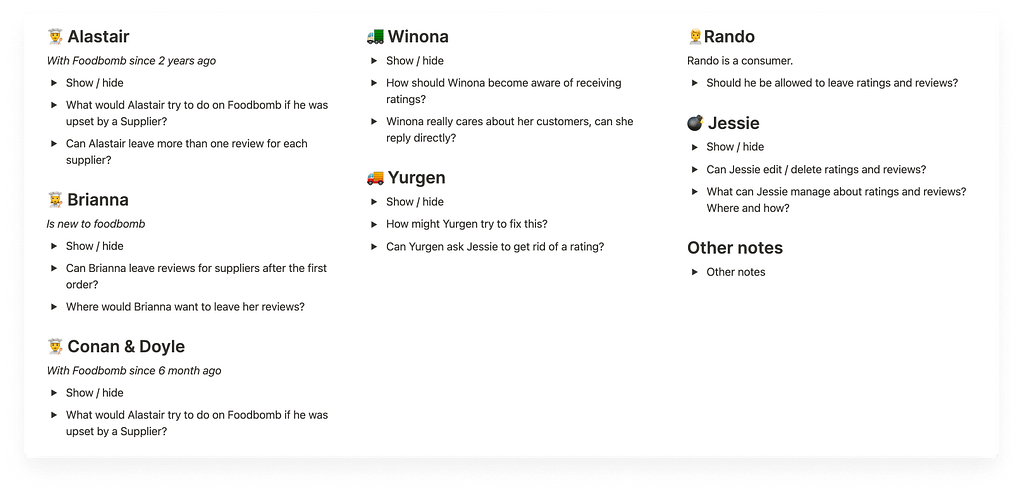Summary
Foodbomb is a marketplace where venues (such as restaurants and cafes) can access hundreds of wholesale suppliers, purchase their produce, and optimise their ordering processes. For suppliers, Foodbomb is a platform that works both as their biggest salesforce, as well as a crucial tool to manage their catalogue, stock levels, and ordering process.
As a result of our foundational research project, one of the key insights was that a vast number of newly signed up venues felt overwhelmed by the number of suppliers they could choose from, and ended up never deciding and sticking to their current flow. A classic case of sunk cost fallacy!
The finding was then a core reason that supported our prioritising this feature. In this page, I will take you through how the feature went from conception, all the way in front of our customers, without talking about the technical discussions. If you’d like to hear about those, please reach out.
Structure
For this feature, I’ve structured a number of activities that were initially informed by the research our team conducted during the prior months. Research activities included quantitative analysis (how many users drop off after signing up), screen recording reviews (hypothesising why users might drop off), qualitative interviews (validating the hypotheses).
Based on this prior work, I have organised a set of activities that included the engineering team, and brought the stakeholders in at various stages. Below I will take you through each one of these activities at a very high level of detail, only omitting sensitive information.
Mini personas workshop
Oct 15, 2020
Objectives:
- Understand and define users needs
- Create shared clarity about the problems
This was the initial workshop I’ve organised to identify customer needs together with the major stakeholders for this feature (CEO, COO, Head of Product, 2 Engineers). I’ve built the mini-personas based on qualitative research. Each mini-persona was assigned to a participant and I facilitated the activities leading to identifying user needs.

Mini-persona example
Alastair owns two coffee shops (he doesn’t cook in either), one in Surry Hills, and one in Parramatta. He’s a very vindictive person and when someone does him wrong, he wreaks havoc upon them.
What would Alastair try to do on Foodbomb if he was upset by a Supplier?
- He wants to shame them publicly
- Doesn’t know how to use social media
- They sometimes think Foodbomb IS the supplier and this causes problems
Can Alastair leave more than one review for each supplier?
- Only if he has ordered from them before
- Foodbomb should be able to audit the reviews before they go up
- He might lose trust in all the reviews if his review didn’t go online instantly, because he might imagine that all the reviews are subject to audit
- You should be able to review post order – not on the checkout page because you have to order again to get a chance to review
- We’d need comms for what happens once you left an
R&R
- We’d need comms for what happens once you left an
- Can we review
R&R? - We need not mix up the
R&Rfor suppliers and us
Good times workshop
Oct 21, 2020
Objectives:
- Creative solutions ideation
- High level scoping
Now that the whole team has a clear – and shared – idea about what the users needs are, and which are the problems we are trying to solve, it’s time for solution mode. In this workshop, I invited the team to do 5 things:
- Define clear user flows
- Search the world wide web for existing solutions (sneaky peaky)
- Sketch up a number of solutions
- Vote on scoping and ideas awesomeness
- Openly discuss on the decision to narrow down the technical scope

While the workshop is shaping up, I made sure to write down and share each decision we made. This process, yet a little daunting for the facilitator from a cognitive perspective, is the core structure that is going to inform the next step of the development; that is the design phase.

Design details and FAQ
Oct 29, 2020
Note: to define this, I conducted one-on-one chats with stakeholders, as well as called up a few customers.
Objectives:
- Review users flow
- Gather feedback on the feature
The most important artifact that came out of the workshop, was the flow of information throughout the whole ratings process. The diagram you can see here was in fact instrumental in developing a clear and shared understanding of the whole process. With this tool at hand, every chat with both stakeholders and customers revealed new hidden assumptions that we were able to shed light upon.

With all this in mind, I was finally able to move forward with designing the actual feature, confident that it would cover at least 90% of the core users needs we became aware as a group.
Stakeholder review
Nov 03 2020
Objectives:
- Review feature with stakeholders
- Shed light on any open question
Even though these are occasionally not included in case studies, I believe that it is important to
Emails
Nudges to venues
- To Venue | Congratulations on your first order! Sent on the day after delivery day + CTA to review supplier
- To Venue | How are you liking
Supplier name? Sent if venue placed 10 orders and hasn’t reviewed yet
Whenever a venue submits a review
- To Supplier | You received a review on Foodbomb
- To Fb admin (reviews[at]foodbomb.com.au) |
Supplierreceived a review fromVenue
Whenever a supplier submits a reply
- To Venue |
Supplierreplied to your review on Foodbomb - To Fb admin (reviews[at]foodbomb.com.au) |
Supplierreplied to venue Y review
Whenever Foodbomb submits a reply
- To Venue | Foodbomb replied to your review
- To Supplier | Foodbomb replied to your reply










